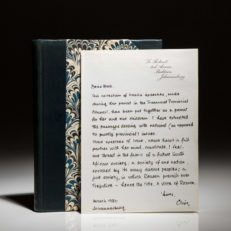Description
Archive of photographs, letters, military documents, and medals chronicling the 12th Armored Division and its liberation of a Dachau concentration subcamp, as described by Staff Sergeant John W. Thompson.
All pieces outline the duration of Thompson’s time in an artillery battery, with numerous letters written to his mother, Mrs. C.S. Thompson, detail the assignments of the division as much as censors would allow. On October 14, 1944, Thompson wrote: “Now that the censor has let up a little you can expect a little more mail from me. Up to this time my trouble has been trying to think of something to write about.” Thompson was present for the 12th’s attachment to the Third Army Group under General George S. Patton, generating the nickname “Mystery Division” for the masking of all 12th-related insignia to better blend with the Army. On April 15, 1945, he wrote: “A few weeks ago we started out with Patton on his drive from Luxembourg to Worms and from Worms to Wurzburg.”
Not long after this assignment, the 12th Division secured Landsberg, which unveiled the horrors of a series of Dachau concentration subcamps in southern Bavaria. “We overran the place on the big drive with the 3rd Army. We got there about a half hour after the SS left. The whole place was in flames… After the fire burned down, we found what you see in the pictures” (August 9, 1945). Includes four 3″x5″ photos showing holocaust victims. There is a gap in the letters after this encounter, which Thompson later explains was due to multiple division and battalion transfers. Throughout the fall and winter of 1945, he was a part of the 3rd Armed Division, the 36th Division, and 29th Division in Bremen. Although it was rumored the men would return home by Christmas of 1945, Thompson was honorably discharged on January 9, 1946.
Full archive includes: four insignia medals (Bronze Star, shoulder patch, chest ribbons, sergeant stripes, and DUI pins); nine military documents (training orders, placement orders, telegraphs, discharge papers); twenty-three letters (V-Mail, handwritten, cards); 18 photographs (varying sizes: fellow soldiers, concentration camp aftermath, European architecture). All pieces housed in archival plastic binder sheets, held together in a one-inch binder.
The 12th Armored Division arrived in Le Havre on November 15, 1944 and fought through France and Germany. They fought in the Battle of the Bulge and faced 1,700 casualties in the combat surrounding Herrlisheim. The division crossed the Rhine with General Patton, then captured a number of bridges to aid in the shipment of supplies to Allied troops in Germany and Bavaria. They moved southward alongside the Seventh Army and reached Landsberg on April 27, 1945. The 12th is recognized as the liberating unit for the Landsberg concentration camp near Landsberg Prison. Landsberg was a subcamp of the Dachau concentration camp, the longest-running camp which opened in 1933. It was originally designed for Hitler’s political opponents including communists and democrats, but it was used as a forced labor camp and imprisoned Jewish people, Romani, and German criminals. The 12th also liberated Oflag VII, a German Army POW camp for Polish officers and later rescued Frenchmen from an Alpine castle while fighting in the Battle for Castle Itter.












